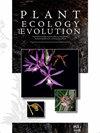A new purple-flowered Butia (Arecaceae) from the highlands of the Chapada dos Veadeiros (Brazil)
IF 1.3
4区 生物学
Q3 PLANT SCIENCES
引用次数: 0
Abstract
Background and aims – The highlands of the Chapada dos Veadeiros region comprise one of the largest savannah areas in central Brazil. The region includes large areas of the rare and little-known cerrado rupestre, which is home to numerous endemic species. During research on the Arecaceae flora of Chapada dos Veadeiros, a new species of Butia was discovered, and it is described here. Material and methods – The morphology and anatomy are described based on field collections. Following the default methodology, pinnae and flowers were analysed using LM (freehand cross- and longitudinal sections) and SEM. The new species is compared to its morphologically similar species from the Brazilian central plateau, and an identification key and distribution map were established. Key results – At first sight, the new species Butia soffiae resembles B. archeri , but with staminate and pistillate flowers, which are always purple, different in size, and congested in the rachillae. After close inspection, it is morphologically allied to B. buenopolensis , differing mainly by its glaucous peduncular bract – similar size to the inflorescence, herbaceous peduncle, numerous rachillae, purple floral colour, and inconspicuous staminodes. Differences in leaf anatomy, such as the presence of raphides, a cross-sectionally truncated midrib, and the number of accessory bundles on the midrib, also support the description of a new species. Two structures were recorded for the first time for the genus: squamiform trichomes at the base of the pistil and osmophores on the staminodes. The new species is assessed as Critically Endangered based on the restricted area of occurrence and anthropogenic threats. Conclusion – Butia soffiae is the first endemic Butia species described in Chapada dos Veadeiros. The type population is located near Chapada dos Veadeiros National Park, which is the subject of a bill that aims to reduce its area by 73%. The discovery of this new species reinforces the uniqueness of the local flora and the importance of maintaining the park.一种新的开紫色花的槟榔科植物(槟榔科)
背景和目的——Chapada dos Veadeiros地区的高地是巴西中部最大的草原地区之一。该地区包括大片罕见而鲜为人知的塞拉多鲁佩斯特,这里是许多特有物种的家园。在对番荔枝槟榔科植物区系的研究中,发现了一种新的槟榔属植物,现对其进行描述。材料和方法-形态学和解剖学描述基于现场收集。按照默认的方法,使用LM(徒手横截面和纵剖面)和SEM分析羽状花序和花朵。将该新种与巴西中部高原形态相似的种进行了比较,并建立了鉴定键和分布图。关键结果-乍一看,新物种Butia soffae类似于B. archeri,但具有雄蕊和雌蕊花,这些花总是紫色的,大小不同,并且在茎轴上拥挤。经过仔细观察,它在形态上与布纳诺波兰相近,主要区别在于其白霜花序苞片-与花序相似的大小,草本花序,许多小轴,紫色的花,和不明显的雄蕊。叶片解剖结构上的差异,如裂口的存在、横截的中脉和中脉上的副束的数量,也支持了对新种的描述。本属首次记录到两个结构:雌蕊基部的鳞状毛状体和雄蕊上的渗透孔。根据发生限制区域和人为威胁,将新种评估为极度濒危物种。结论-软Butia soffae是中国第一个发现的特有Butia物种。这种类型的种群位于Chapada dos Veadeiros国家公园附近,该公园是一项旨在将其面积减少73%的法案的主题。这个新物种的发现加强了当地植物群的独特性和维护公园的重要性。
本文章由计算机程序翻译,如有差异,请以英文原文为准。
求助全文
约1分钟内获得全文
求助全文
来源期刊

Plant Ecology and Evolution
PLANT SCIENCES-
CiteScore
2.20
自引率
9.10%
发文量
27
审稿时长
>12 weeks
期刊介绍:
Plant Ecology and Evolution is an international peer-reviewed journal devoted to ecology, phylogenetics and systematics of all ‘plant’ groups in the traditional sense (including algae, cyanobacteria, fungi, myxomycetes), also covering related fields.
The journal is published by Meise Botanic Garden and the Royal Botanical Society of Belgium.
 求助内容:
求助内容: 应助结果提醒方式:
应助结果提醒方式:


